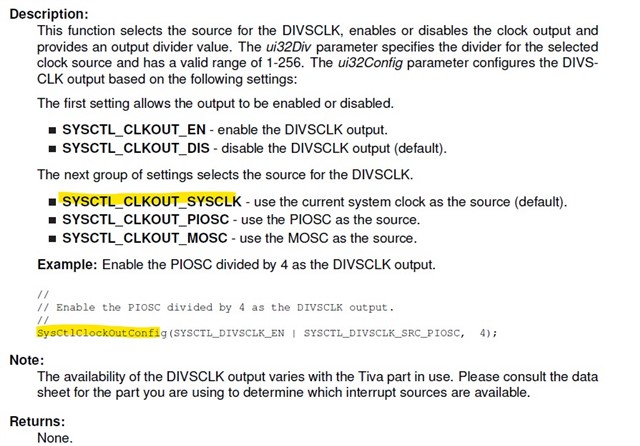Tool/software:
Dear TI Support Team,
I am working with the MSP432E4 MCU and attempting to generate a PWM signal on PF1 (M0PWM1). The PF1 pin is connected to an FPGA on the other side, where the PWM output will be used as a reference clock.
I have configured the system clock to 120 MHz using the PLL and enabled PWM0. The PF1 pin is configured as GPIO_PF1_M0PWM1, and I am using PWM Generator 0, Output 1. My code is based on TI’s driverlib, and I followed the standard initialization steps:
-
System clock set to 120 MHz
-
SysCtlPeripheralEnable()for GPIOF and PWM0 -
SysCtlPWMClockSet(SYSCTL_PWMDIV_1)for maximum PWM resolution -
PF1 configured using
GPIOPinConfigure(GPIO_PF1_M0PWM1)andGPIOPinTypePWM() -
PWMGenConfigure(PWM0_BASE, PWM_GEN_0, PWM_GEN_MODE_DOWN) -
PWMGenPeriodSet()andPWMPulseWidthSet()used to configure period and duty cycle -
PWMOutputState()andPWMGenEnable()called
However, I am observing that PF1 remains always high or if i change anything i could not see any output in the PF1 Pin. Even when I configure for a low frequency (e.g., 1 kHz with 50% duty cycle), I do not see the expected waveform.
Could you please clarify the following points?
-
Is there any additional configuration required for M0PWM1 (PF1) output?
-
Are there known limitations on maximum PWM frequency achievable on PF1?
-
Could there be any restriction when driving an FPGA input directly from the PWM pin?
Here below i am giving my code for your reference,
#include <stdint.h>
#include <stdbool.h>
#include "ti/devices/msp432e4/driverlib/driverlib.h"
#define SYSTEM_CLOCK_HZ 120000000 // 120 MHz system clock
#define PWM_FREQUENCY 1000 // 1 kHz for easy observation
#define PWM_DUTY_PERCENT 50 // 50% duty cycle
uint32_t ui32SysClock;
uint32_t ui32Period;
// 1. Configure system clock for 120 MHz using PLL
ui32SysClock = SysCtlClockFreqSet(
(SYSCTL_XTAL_25MHZ |
SYSCTL_OSC_MAIN |
SYSCTL_USE_PLL |
SYSCTL_CFG_VCO_480),
SYSTEM_CLOCK_HZ);
// 2. Enable peripherals
SysCtlPeripheralEnable(SYSCTL_PERIPH_PWM0);
SysCtlPeripheralEnable(SYSCTL_PERIPH_GPIOF);
while(!SysCtlPeripheralReady(SYSCTL_PERIPH_PWM0));
while(!SysCtlPeripheralReady(SYSCTL_PERIPH_GPIOF));
// 3. Configure PF1 as M0PWM1
GPIOPinConfigure(GPIO_PF1_M0PWM1);
GPIOPinTypePWM(GPIO_PORTF_BASE, GPIO_PIN_1);
// 4. Disable generator before configuration
PWMGenDisable(PWM0_BASE, PWM_GEN_0);
// Configure generator 0 for down-count mode
PWMGenConfigure(PWM0_BASE, PWM_GEN_0, PWM_GEN_MODE_DOWN);
// 5. Set PWM period and duty cycle
ui32Period = (ui32SysClock / PWM_FREQUENCY);
PWMGenPeriodSet(PWM0_BASE, PWM_GEN_0, ui32Period);
// Set duty cycle = 50%
PWMPulseWidthSet(PWM0_BASE, PWM_OUT_1, (ui32Period * PWM_DUTY_PERCENT) / 100);
// 6. Enable PWM output
PWMOutputState(PWM0_BASE, PWM_OUT_1_BIT, true);
// Enable generator
PWMGenEnable(PWM0_BASE, PWM_GEN_0);
while(1)
{
// Loop forever – PWM runs in hardware
}
I would appreciate your guidance in resolving this issue, as PF1 output is crucial for my design.
Regards,
J.Manikandasamy


